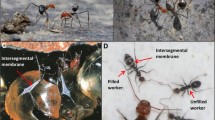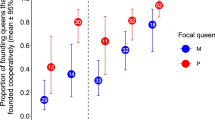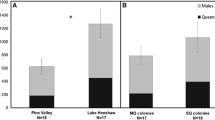Abstract
The colony structures of social insects vary greatly among species. In ant societies, the number of queens within a colony is variable during colony maturation. We investigated the social structure of a polygynous ant Crematogaster osakensis in a series of field and laboratory experiments. First, the initial colonies headed by multiple queens were found in the field. In laboratory experiments, queens that were artificially cohabited after their nuptial flight harmoniously co-existed even in the presence of newly emerged workers, suggesting that mated queens of this species can establish their colony cooperatively as primary polygynous colonies. In addition, the mating frequency of a queen was typically more than one, estimated from the sperm number stored in field-collected males and queens, and from genetic relatedness among daughters of lab-reared monogynous colonies. Second, our assessment of genetic relatedness in a mature field colony of this species revealed that dealated queens, as well as workers and alates, were relatives. The number of developed oocytes identified reproductive skew in two of five field-collected nests. Moreover, under laboratory conditions, the most fertile egg layer altered over 3 months of observation. Based on these lines of evidence, we propose that in C. osakensis, polygynous foundresses might either be unrelated and subsequently be replaced by daughter queens of particular foundresses, or be related in the first place.






Similar content being viewed by others
References
Bernasconi G, Strassmann JE (1999) Cooperation among unrelated individuals: the ant foundress case. Trends Ecol Evol 14:477–482
Blaimer BB (2012) A subgeneric revision of Crematogaster and discussion of regional species-groups (Hymenoptera: Formicidae). Zootaxa 3482:47–67
Boomsma JJ, Ratnieks FLW (1996) Paternity in eusocial Hymenoptera. Philos Trans R Soc Lond B 351:947–975
Boomsma JJ, Huszár DB, Pedersen JS (2014) The evolution of multiqueen breeding in eusocial lineages with permanent physically differentiated castes. Anim Behav 92:241–252
Cahan SH (2001) Ecological variation across a transition in colony-founding behavior in the ant Messor pergandei. Oecologia 129:629–635
Debout G, Schatz B, Elias M, Mckey D (2007) Polydomy in ants: what we know, what we think we know, and what remains to be done. Biol J Linnean Soc 90:319–348
Dobata S, Shimoji H, Ohnishi H, Hasegawa E, Tsuji K (2011) Paternally inherited alleles in male body parts of an ant (Diacamma sp.) sex mosaic: implication for androgenetic male production in the Hymenoptera. Insect Soc 59:55–59. doi:10.1007/s00040-011-0187-5
Feldhaar H, Fiala B, Hashim R, Maschwitz U (2003) Dynamics of the Crematogaster-Macaranga association: the ant partner makes the difference. Insect Soc 50:9–19
Feldhaar H, Fiala B, Gadau J (2005) A shift in colony founding behaviour in the obligate plant-ant Crematogaster (Decacrema) morphospecies 2. Insect Soc 52:222–230
Frizzi F, Santini G, Natali C, Chelazzi G, Ciofi C (2009) Characterization of polymorphic microsatellite loci in the ant Crematogaster scutellaris. Conserv Genet Resour 1:425–428. doi:10.1007/s12686-009-9098-4
Gotoh A, Ito F (2008) Seasonal cycle of colony structure in the Ponerine ant Pachycondyla chinensis in western Japan (Hymenoptera, Formicidae). Insect Soc 55:98–104
Heinze J, Strätz M, Pedersen JS, Haberl M (2000) Microsatellite analysis suggests occasional worker reproduction in the monogynous ant Crematogaster smithi. Insect Soc 47:299–301
Heinze J, Trunzer B, Hölldobler B, Delabie JHC (2001) Reproductive skew and queen relatedness in an ant with primary polygyny. Insect Soc 48:149–153
Herbers JM (1986) Nest site limitation and facultative polygyny in the ant Leptothorax longispinosus (Hymenoptera: Formicidae). Behav Ecol Sociobiol 19:115–122
Hölldobler B, Carlin NF (1985) Colony founding, queen dominance and oligogyny in the Australian meat ant Iridomyrmex purpureus. Behav Ecol Sociobiol 18:45–58
Hölldobler B, Wilson EO (1977) The number of queens: an important trait in ant evolution. Naturwissenschaften 64:8–15
Hölldobler B, Wilson EO (1990) The Ants. Belknap Press, Cambridge
Hosoishi S, Ogata K (2016) Systematics and biogeography of the ant genus Crematogaster Lund subgenus Orthocrema Santschi in Asia (Hymenoptera: Formicidae). Zool J Linn Soc 176:547–606
Huang K, Ritland K, Guo ST, Shattuck MR, Li BG (2014) A pair-wise relatedness estimator for polyploids. Mol Ecol Res 14:734–744. doi:10.1111/1755-0998.12217
Hughes WOH, Ratnieks FLW, Oldroyd BP (2008) Multiple paternity or multiple queens: two routes to greater intracolonial genetic diversity in the eusocial Hymenoptera. J Evol Biol 21:1090–1095
Ito F (1993) Social organization in a primitive ponerine ant: queenless reproduction, dominance hierarchy and functional polygyny in Amblyopone sp. (reclinata group) (Hymenoptera: Formicidae: Ponerinae). J Nat Hist 27:1315–1324
Ito F, Yusoff NR, Idris AH (1996) Colony composition and queen behavior in polygynous colonies of the oriental ponerine ant Odontomachus rixosus (Hymenoptera Formicidae). Insectes Soc 43:77–86. doi:10.1007/BF01253958
Japanese Ant Database Group (2008) Japanese Ant Image Database 2008. Japanese Ant Database Group, CDROM, Sendai (in Japanese)
Jerome CA, Mclnnes DA, Adams ES (1998) Group defense by colony-founding queens in the fire ant Solenopsis invicta. Behav Ecol 9:301–308
Keller L (1988) Evolutionary implication of polygyny in the Argentine ant, Iridomyrmex humilis (Mayr) (Hymenoptera:Formicidae): an experimental study. Anim Behav 36:159–165
Keller L (1995) Social life: the paradox of multiple-queen colonies. Trends Ecol Evol 10:355–360
Keller L (1998) Queen lifespan and colony characteristics in ants and termites. Insect Soc 45:235–246
Keller L, Reeve HK (1994) Genetic variability, queen number, and polyandry in social Hymenoptera. Evolution 48:694–704
Kellner K, Trindl A, Heinze J, D’ettorre P (2007) Polygyny and polyandry in small ant societies. Mol Ecol 16:2363–2369
Kolmer K, Hölldobler B, Heinze J (2002) Colony and population structure in Pachycondyla cf. inversa, a ponerine ant with primary polygyny. Ethol Ecol Evol 14:157–164
Minzer A, Vinson SB (1985) Cooperative colony founding by female of the leaf cutting ant Atta texana in the laboratory. J NY Entomol Soc 93:1047–1051
Pamilo P (1993) Polyandry and allele frequency differences between the sexes in the ant Formica aquionia. Heredity 70:472–480
Pedersen JS, Boomsma JJ (1999) Effect of habitat saturation on the number and turnover of queens in the polygynous ant, Myrmica sulcinodis. J Evol Biol 12:903–917
Qian Z-Q, Schlüns H, Schlick-Steiner BC, Steiner FM, Robson SKA, Schlüns EA, Crozier RH (2011) Intraspecific support for the polygyny-vs.-polyandry hypothesis in the bulldog ant Myrmecia brevinoda. Mol Ecol 20:3681–3691
Rissing SW, Pollock GB (1991) An experimental analysis of pleometrotic advantage in the desert seed-harvester ant Messor pergandei (Hymenoptera; Formicidae). Insect Soc 38:205–211
Rissing SW, Pollock GB, Higgins MR, Hagen RH, Smith DR (1989) Foraging specialization without relatedness or dominance among co-founding ant queens. Nature 338:420–422
Rubin BER, Anderson RM, Kennedy D, Palmer TM, Stanton ML, Lovette IJ (2013) Polygyny in the nest-site limited acacia-ant Crematogaster mimosae. Insect Soc 60:231–241
Schuelke M (2000) An economic method for the fluorescent labeling of PCR fragments: a poor man’s approach to genotyping for research and high-throughput diagnostics. Nat Biotechnol 18:233–234
Sommer K, Hölldobler B (1995) Colony founding by queen association and determinants of reduction in queen number in Lasius niger. Anim Behav 50:287–294
Trunzer B, Heinze J, Hölldobler B (1998) Cooperative colony founding and experimental primary polygyny in the ponerine ant Pachycondyla villosa. Insect Soc 45:267–276
Tschinkel WR (1992) Brood raiding in the fire ant, Solenopsis invicta (Hymenoptera: Formicidae): laboratory and field observations. Ann Ent Soc Am 85:638–646
Tschinkel WR, Howard DF (1983) Colony founding by pleometrosis in the fire ant, Solenopsis invicta. Behav Ecol Sociobiol 12:103–113
Tsuji K, Tsuji N (1996) Evolution of life history strategies in ants: variation in queen number and mode of colony founding. Oikos 76:83–92
Acknowledgements
We thank Atsushi Mitsunaga, Takuma Hashimoto, Taishi Ohbe, Kento Furukawa, Manami Misaki, Masaki Shiota, Mitsuhiro Obika, Riou Mizuno, Yuka Onishi, and Saki Ishida in Kagawa University and Yutaka Daido in Konan University for their assistance with sample collection, and Hiroyuki Shimoji for his advice in network analysis. We are very grateful to two reviewers for their useful comments on the manuscript. This work is supported by a JSPS Research Fellowships for Young Scientists (23-3964).
Author information
Authors and Affiliations
Corresponding authors
Electronic supplementary material
Below is the link to the electronic supplementary material.
40_2016_522_MOESM1_ESM.jpg
Fig. S1 A network based on relatedness between queens collected from nest F-J. Each node represents a queen, clustered by their nests of origin, and edges were given when the pairwise relatedness was significantly greater than zero. All nodes were interconnected, indicating they are all relatives. (JPG 56 kb)
Rights and permissions
About this article
Cite this article
Gotoh, A., Dansho, M., Dobata, S. et al. Social structure of the polygynous ant, Crematogaster osakensis . Insect. Soc. 64, 123–131 (2017). https://doi.org/10.1007/s00040-016-0522-y
Received:
Revised:
Accepted:
Published:
Issue Date:
DOI: https://doi.org/10.1007/s00040-016-0522-y




